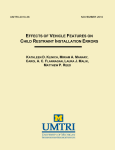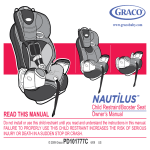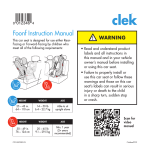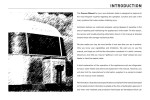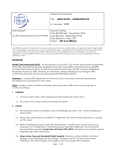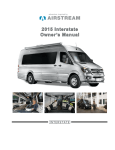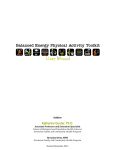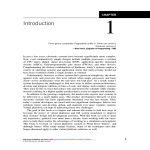Download MODULE 9 • Children in Forward-Facing Car Seats
Transcript
National Child Passenger Safety Certification Training Program MODULE 9 • Children in Forward-Facing Car Seats Module Agenda: 125 Minutes Suggested Timing Topic 1. Introduction 2. When Children Should Travel Forward-Facing 3. Types of Forward-Facing Car Seats • Practice Activity: Adjust a Harness and Locate the Belt Path 4. 5 Steps For Forward-Facing Car Seat Use • Video: Install a Forward-Facing Car Seat • Practice Activity: Select and Install Forward-Facing Car Seats 5. Best Practices for Caregivers • Progress Check: Explain Best Practices About Forward-Facing Car Seats • Video: Loose LATCH and No Tether video • Video: Incorrect Belt Routing and No Tether video 6. Forward-Facing Car Seat Errors and Consequences • Progress Check: Identify Forward-Facing Car Seat Errors and Consequences • Progress Check: Identify Misuse with Car Seats 7. Progress Check and Summary TOTAL 2 2 15 55 10 30 11 125 Minutes Module Purpose The purpose of this module is to learn about selection, direction, location, installation, and harnessing with different types of forward-facing car seats. Participants will also learn how to explain best practices and identify forward-facing car seat errors and consequences. Module Objectives • • • • • Describe when children should travel forward-facing. Identify types of forward-facing car seats. Apply 5 steps for forward-facing car seat use. Explain best practices about forward-facing car seats to caregivers. Identify forward-facing car seat errors and consequences. Instructor Guide • Page 9-1 Special Media, Materials, and Resources • • • • • • • • • • • • • • • • • Manufacturer instructions for each car seat Forward-facing car seats with harnesses (convertible, combination, forward-facing-only) Car seat with harness adjuster: bar Car seat with harness adjuster: front adjustment Forward-facing car seat with rigid LATCH Forward-facing car seat with flexible LATCH Forward-facing car seat with higher weight limits Non-regulated products such as padding, etc. Recall List (NHTSA website at www.nhtsa.gov) Vehicle with integrated seat Safety vests LATCH Manual (if available) Child cards Role play cards Seat belt simulation or belt demonstration seat Doll for each small group Vehicles for installation activities Video Titles and Times • • • Install a Forward-Facing Car Seat, 2:57 minutes (PPT 9-12) LATCH & Tether Use, :16 minutes (PPT 9-22) Incorrect Belt Routing & No Tether, :16 minutes (PPT 9-23) Activities • • • • • • Practice Activity: Adjust a Harness and Locate the Belt Path Practice Activity: Select and Install Forward-Facing Car Seats Progress Check: Explain Best Practices About Forward-Facing Car Seats Progress Check: Identify Forward-Facing Car Seat Errors and Consequences Practice Activity: Identify Misuse with Car Seats Final Progress Check Preparation • • • • Prepare for the practice activities and progress checks in this module. Review the video for this module. Have the following “child cards” available: − 2-year-old, 34 inches, 24 pounds − 4-year-old, 42 inches, 38 pounds − 18-month-old, 32 inches, 26 pounds − 5-year-old, 48 inches, 63 pounds − 2-year-old, 36 inches, 32 pounds − 3-year-old, 37 inches, 33 pounds Collect/prepare the car seats and other items noted in the Special Media, Materials, and Resources list for the practice activities. Instructor Guide • Page 9-2 What To Do 1. Talking Points • Activity Directions & Summaries Introduction Display PPT 9-1. Present module purpose. The purpose of this module is to learn about selection, direction, location, installation, and harnessing with different types of forward-facing car seats. You will also learn how to explain best practices and identify forward-facing car seat errors and consequences. Display PPT 9-2. Present module objectives. As a result of this module, you will be able to: • • • • • 2. Describe when children should travel forward-facing. Identify types of forward-facing car seats. Apply 5 steps for forward-facing car seat use. Explain best practices about forward-facing car seats to caregivers. Identify forward-facing car seat errors and consequences. When Children Should Travel Forward-Facing Reference TG page 9-1. Display PPT 9-3. Review when children should travel forwardfacing. Children should: • Remain in a rear-facing car seat until reaching the top height or weight limit allowed by the car seat manufacturer. • Ride in a forward-facing car seat with a harness until they reach the top height or weight limit allowed by the car seat manufacturer – usually until they are between ages 4 to 7. • It is dangerous to exceed height or weight limits. Instructor Guide • Page 9-3 What To Do 3. What To Say • Activity Directions & Summaries Types of ForwardFacing Car Seats Reference TG page 9-1. Display PPT 9-4. Introduce types of forward-facing car seats. There are five types of forward-facing car seats: • • • • • Convertible Combination Forward-facing-only Large medical seats or vests Integrated seats There are always car seats that do not fit into these categories. For example, there are car seats that rear-face, forward-face, and then become booster seats. Display PPT 9-5. [INSTRUCTOR NOTE] Review convertible car seats. [Show a convertible car seat with only the top slot reinforced.] Let’s discuss the features of each forward-facing car seat. We will start with the convertible car seat. • Manufacturer instructions for many car seats recommend they be in the upright position when used forward-facing. • Some manufacturers meet testing standards with their seat in a forward-facing, semi-reclined position, as well as fully upright. Consider this position if the child has special needs or if seat belts cannot be made tight when the car seat is upright. • Some harness systems are approved for use to 40 pounds, but the marketplace is changing and now includes more seats with higher weight limit harnesses. • A 5-point harness provides more protection for a child than a booster seat with a lap-and-shoulder seat belt. • Read the owner's manual to ensure correct use of the belt path and harness slots. Instructor Guide • Page 9-4 What To Do Talking Points • Activity Directions & Summaries [INSTRUCTOR NOTE] [Tell participants that a common error with convertible seats is the use of harness slots that are not designed or reinforced, for forward-facing use.] Display PPT 9-6. Reference TG page 9-2. Review forward-facing combination car seats. [INSTRUCTOR NOTE] Ask question and respond to comments. The forward-facing combination car seat is used with a harness until a certain height or weight limit specified by the manufacturer is reached. The harness must then be removed or stored. • Make sure the mid-point of the back of head or top of ears are NOT above the top of the shell or as directed by the car seat manufacturer. • The back of all combination seats is reinforced. Any harness slot can be used as long as it is at or above the child’s shoulders. • This car seat does not have air bag warning labels because combination car seats are forward-facing-only and most have a lower weight limit of 20 pounds. • Once the harness is removed, this seat can then be used as a belt-positioning booster seat. [Tell participants that a common error is to assume that the top slot only is used on a combination seat.] Q. Why do you think a combination seat does not have an air bag warning label? A. This seat should NEVER be used rear-facing. Best practice would be to make sure a child is NOT placed in a seating position in front of an air bag. Sometimes in real-world situations, the caregiver may need to make the choice of placing a child in front of an air bag. Caregivers should be instructed NEVER to place a rear-facing car seat in front of an air bag. If a child in a forward-facing car seat must be placed in front of an air bag, the vehicle seat needs to be moved back as far as possible. [INSTRUCTOR NOTE] [Demonstrate the difference between a forward-facing convertible seat and a combination seat.] Instructor Guide • Page 9-5 What To Do What To Say • Activity Directions & Summaries Display PPT 9-7. Review forward-facing- Forward-facing-only car seats are sometimes used for children only car seats. with special health needs or for heavier children who are not behaviorally mature enough for a booster seat. • With forward-facing-only car seats, the weight limits can vary. Some have higher harness weight limits than other forward-facing car seats. • It is important to research and remain aware of currently available car seats with higher weight harnesses. Display PPT 9-8. Review large medical seats and vests. Large medical seats, vests, and harnesses may help children with behavioral issues, weak muscles, excess weight, or other situations when a conventional car seat cannot be used. • Large medical seats are designed for occupants who require supplemental positioning support from a car seat beyond that offered by a conventional restraint. Typically, large medical seats will fit occupants weighing up to 102 to 135 pounds (a few go higher). • There are different vests available in different sizes for use as restraints. In order to use a vest, a child must have good head control. Some products are made just for school bus use. • It’s important for families to work with an occupational therapist (OT) or physical therapist (PT) to evaluate a child’s positioning needs and determine which restraint provides the best positioning options for the child. • Heavy-duty tethers are sometimes required. • Always follow the manufacturer instructions. Display PPT 9-9. Reference TG page 9-3. Instructor Guide • Page 9-6 What To Do Review integrated seats. Talking Points • Activity Directions & Summaries Some vehicles have seats/restraints built into the vehicle. Check the vehicle owner’s manual for instructions and weight limits. • Many integrated seats face forward. Some can be used as a booster seat. They CANNOT be moved. • Some have a 5-point harness. • Integrated seats, as with other car seats, may need to be replaced after a vehicle collision, if webbing is frayed, or parts are missing or broken. Check the vehicle owner’s manual for instructions. • Caregivers should call the service department of the vehicle dealership and ask to be given information in the repair section of the service manual about replacing car seat parts. Display PPT 9-10. Review harness fit. Tighten harness straps snugly. A snug harness lies flat and passes the pinch test. Bulky clothing can interfere with proper harness fit. • Avoid bulky clothing or padding behind the child’s head, back, or under buttocks. • Bulky jackets can be put on backwards (over the child’s arms and torso) after the harness is secured. • Place blankets over and around the child after the harness is snug. Children should sit with: [INSTRUCTOR NOTE] • Their back and bottom flat against the car seat back. • The harness placed through proper slots, usually at or above the child’s shoulders. Refer to the car seat manufacturer instructions. • The harness straps placed over the shoulders and buckled at the crotch. • The retainer clip at armpit level. [Refer participants to Tips for Discussing Harness Fit on page 9-3 in their TGs.] Instructor Guide • Page 9-7 What To Do What To Say • Activity Directions & Summaries Reference TG page 9-4. Conduct practice activity and debrief. Now you will work in a small group to adjust a harness for height and weight limits. 1. Working with a forward-facing car seat and doll, move the harness to a different harness slot. Adjust the harness to loosen and tighten. 2. Adjust the car seat harness so it fits the doll. 3. Identify the location of the harness adjustments. 4. Identify the forward-facing seat belt path, lower anchor connector belt path, and tether strap on the car seat. 5. Adjust the car seat to either the upright or forward-facing recline position (if allowed by the manufacturer). 6. Answer the questions located in your TGs. [INSTRUCTOR NOTE] [Divide the class into small groups. Provide the class with several forward-facing car seats with lower anchor connectors from which to choose and a child (doll). Participants will review car seat labels to identify height and weight limits and identify the correct belt path. Assign each group a child from the following list: • • • • • • 2-year-old, 34 inches, 24 pounds 4-year-old, 42 inches, 38 pounds 18-month-old, 32 inches, 26 pounds 5-year-old, 48 inches, 63 pounds 2-year-old, 36 inches, 32 pounds 3-year-old, 37 inches, 33 pounds Encourage participants to rely on the manufacturer instruction manual to find the harness adjuster part, determine if there are instructions that state which specific harness slot to use, and locate the correct belt path. Give participants 20 minutes for this practice activity. Ask each group to explain which car seat they selected and why. Ask if there were any instructions in the car seat manual directing them to use a specific harness slot with that particular car seat. Have participants describe the correct belt path.] Instructor Guide • Page 9-8 What To Do Ask question and respond to comments. 4. Talking Points • Activity Directions & Summaries Q. What questions do you have about the types of forward-facing car seats? 5 Steps for ForwardFacing Car Seat Use Reference TG page 9-4. Display PPT 9-11. Review 5 steps forward-facing car seat use. Let’s apply the 5 steps for car seat use to forward-facing car seats. Remember, the steps are: 1. Selection: Choose the right car seat. 2. Direction: Face the car seat the right way. 3. Location: Install the car seat in an appropriate location in the vehicle. 4. Installation: Secure the car seat to vehicle in the right way. 5. Harnessing: Place the child correctly in the car seat. Review car seat selection. 1. Selection: Choose the Right Car Seat As with all car seats, select the one that is right for the child’s height, weight, and developmental levels. Review car seat direction. 2. Direction: Face the Car Seat the Right Way A child should be kept in a forward-facing car seat with a harness until reaching the top height or weight limit allowed by the car seat manufacturer. This is generally between the ages of 4 to 7. Review car seat location. 3. Location: Install the Car Seat in the Right Spot in the Vehicle • As with rear-facing car seats, while there may be many seating positions in a vehicle, not all may be suitable for installing a car seat. • As long as the car seat fits, the center-rear seating position may be safer because it is furthest from impact and intrusion from any direction. However, some center-rear positions are not usable and many families transport more than one child. Instructor Guide • Page 9-9 What To Do What To Say • Activity Directions & Summaries • Weight limits on lower and tether anchors can affect the seating position choice. Each vehicle manufacturer sets these weight limits. Check the vehicle owner’s manual or most current LATCH Manual (if available) for individual vehicle limits. Reference TG page 9-5. Review car seat installation. [INSTRUCTOR NOTE] 4. Installation: Secure the Car Seat to the Vehicle in the Right Way • Consider seating positions with seat belts that can be locked (locking latchplate, switchable, or automatic locking retractors) or approved lower anchor positions for car seat use. • A tether increases safety by limiting forward movement and rotation of the car seat. Using the tether strap can stabilize a car seat and limit head movement. • NEVER place noodles or towels behind or under a forward-facing car seat unless allowed by the manufacturer. [Select a variety of vehicles to demonstrate seat belts and lower and tether anchors. Show class the tether and demonstrate how to tightly secure a car seat with a tether (use a demonstration seat or vehicle) by first using the seat belt and then with lower anchor connectors. Demonstrate placing lower anchor connectors through a forward-facing belt path (making sure that the belt is NOT twisted). Have participants look at LATCH instructions found in vehicle and car seat owner’s manuals. Discuss what participants should look for in an owner’s manual to be certain they give caregivers accurate information. Refer participants to the General Methods for Obtaining a Tight Installation and Tips for Discussing Forward-Facing Car Seats in their TGs on page 9-5.] Reference TG page 9-6. Display PPT 9-12. Instructor Guide • Page 9-10 What To Do Introduce Install a Forward-Facing Car Seat video (2:57 minutes). Talking Points • Activity Directions & Summaries This video, Install a Forward-Facing Car Seat, shows the installation steps for installing a forward-facing combination car seat with a harness using a seat belt. • • Watch carefully for the installation steps. Take notes in your TG as you watch the video. Play Install a ForwardFacing Car Seat video. Ask question and respond to comments. Q. What do you need to take into account when using the lower anchors to secure the car seat? A. Be sure to follow weight limits for lower anchors. If the weight limit is exceeded, then use the seat belt. Reference TG page 9-7. Display PPT 9-13. Review common car seat installation errors. Caregivers make the following common forward-facing installation errors: • A seat belt or lower anchor connector that is too loose or not locked • A rear-facing-only car seat that is forward-facing • Seat belt or lower anchor connectors routed incorrectly through the wrong belt path • Recline angle not adjusted appropriately for forwardfacing direction • Using two seat belts, or using a seat belt and lower anchor connectors together (unless allowed by the car seat and the vehicle manufacturers) • Incorrect use of lower anchors and tether, not installing lower anchor connectors to the correct designated lower anchor bars or attaching the connectors upside down • Not using the appropriate tether anchor or using it when it should not be used (when a tether anchor is applicable) Display PPT 9-14. Instructor Guide • Page 9-11 What To Do What To Say • Activity Directions & Summaries • Locking clip installed incorrectly • Installing a car seat with lower anchors in a seating position that is not a designated LATCH position • Installing a seat with LATCH when the child weighs more than the vehicle and/or car seat LATCH weight limits Display PPT 9-15. Display PPT 9-16. Review car seat harnessing. 5. Harnessing: Place the Child Correctly in the Car Seat There are four steps for correctly harnessing a child in a car seat. 1. Place the child all the way back in the car seat. 2. Put the harness straps over the shoulders and buckle at the crotch. The harness holds the child back against the car seat so he or she does not slide out in a crash. The crotch strap keeps the child from moving forward. 3. Tighten the harness straps snugly. You should NOT be able to pinch excess webbing at the shoulders once the harness is buckled. 4. Secure and place the harness retainer clip at armpit level. Display PPT 9-17. Review common car Caregivers make the following common forward-facing seat harnessing errors. harnessing errors: • • • • Harness not used (child just sitting in the car seat) Harness straps are too loose Retainer clip not at armpit level Harness routed through the wrong slots. (NOTE: A harness may look as though it is properly routed through the pad, but it may not be routed correctly through the shell.) • • Harness is twisted or incorrectly routed Harness is not placed on the child correctly Display PPT 9-18. Instructor Guide • Page 9-12 What To Do Talking Points • Activity Directions & Summaries • • • Harness is frayed or damaged Metal adjuster not flush with the slot or out of position Crotch strap that is adjusted too long, or not through slot closest to the child Display PPT 9-19. Ask question and respond to comments. Q. Which part of this installation is an error? Scenario: A 2 ½-year-old, 30-pound child is in a combination seat with a snug harness. The latchplate is sliding and the retractor is switchable in the emergency locking retractor mode. Answer: The retractor must be switched to the automatic locking retractor mode. Reference TG page 9-8. Conduct practice activity and debrief. Now that you have learned about the 5 steps for forwardfacing car seats, you will select and install a forward-facing car seat by a child’s age, height, and weight. 1. Your group becomes the caregivers of a child with a specific age, height, and weight. 2. Select the correct car seat for the child, adjust the harness straps and angle, and determine the belt path. 3. Work together to install your car seat. 4. Document retractor and latchplate types and how your vehicle seat belt locks. 5. If you identify any errors, document them in the second and third charts in your TG. [INSTRUCTOR NOTE] [Form small groups. Assign each small group a child with age, height, and weight. At least one group should have a special needs situation. 1. 7-year-old, 48 inches, 62 pounds, unable to sit alone: Child needs high weight harness car seat to provide trunk control 2. 3-year-old, 39 inches, 37 pounds: Choose combination or 3-in-1 car seat since child will soon outgrow 40-pound limit harness Instructor Guide • Page 9-13 What To Do What To Say • Activity Directions & Summaries 3. 20-month-old, 35 inches, 36 pounds: Forward-facing with harness, preferably a high weight harness car seat since child will likely be very young when 40 pounds 4. 5-year-old, 40 inches, 45 pounds, with behavior problems: Child needs high weight harness 5. 2-year-old, 38 inches, 34 pounds: Forward-facing with harness or high weight harness Participants pick a forward-facing convertible or forwardfacing-only car seat for their child. They will install a forwardfacing convertible and forward-facing-only car seat using a laponly seat belt, lap-and-shoulder seat belt, flexible and rigid lower anchor connectors, and a tether in the vehicle. Set up a misuse of a child in a forward-facing car seat with: • • Harness straps coming from lowest set of slots below the child’s shoulders in a convertible car seat. Lower anchor connectors routed through the rear-facing belt path. NOTE: The misuse portion is ONE small part of the larger practice activity. The entire activity should be signed off. This activity will take up to 30 minutes. Walk around and provide feedback on participant selections and installations. Sign off on TG worksheets once you have checked their work.] 5. Best Practices for Caregivers Reference TG page 9-9. Reinforce how to to explain best practices to caregivers. There are key questions to answer related to forward-facing car seats. Display PPT 9-20 and 9-21. [INSTRUCTOR NOTE] [Review the key questions.] Instructor Guide • Page 9-14 What To Do Talking Points • Activity Directions & Summaries We will review what we learned about forward-facing car seats through a discussion of best practices. 1. Let’s look at each of the questions in your TGs. We will discuss them as a group to help you prepare for conversations you will have with caregivers to educate them about forward-facing car seats. 2. Write down the correct answers in your TGs. [INSTRUCTOR NOTE] [Ask for different volunteers to answer the questions. Debrief the questions as a large group. If time allows, set up one or two scenarios as a role play.] The correct answers follow: 1. My child is two years old and weighs 39 pounds. Which car seat should I buy? Answer: Check the car seat manufacturer instructions. A car seat with a higher weight limit should be used until the child reaches the upper seat limits. 2. May I use this car seat with a side air bag in a back seat? Answer: Check the car seat manufacturer instructions and vehicle owner’s manual. Car seat manufacturers, in most cases, will refer to the vehicle owner’s manual because they do not test their products with side air bags. 3. My child fits in the harness, but weighs 43 pounds. Can I keep using this car seat? Answer: Check the car seat manufacturer instructions for weight limitations. A car seat that has a harness with a higher weight limit may need to be purchased. 4. Should I use LATCH or the seat belt? Answer: Use the system that provides correct installation of the car seat. Do NOT use both systems together unless permitted by both the car seat and vehicle owner’s manuals. Instructor Guide • Page 9-15 What To Do What To Say • Activity Directions & Summaries 5. Do I have to use the tether? Answer: Tethering a forward-facing car seat will reduce forward and side-to-side motion in a crash. It is HIGHLY recommended that a tether ALWAYS be used if allowed by the car seat manufacturer and vehicle owner’s manual. 6. My child climbs out of the car seat. What should I do? Answer: Check to be sure the harness is tight. Stop the vehicle until all are buckled. The child may be testing limits. A vest may be a suitable option.] Display PPT 9-22. Introduce Loose LATCH and No Tether video (:16 seconds). Now, let’s look at two videos so you can see the dangers of misuse when installing seats. Watch what can happen when the lower anchor connectors are loose and a tether is not used. You can compare the difference in the side-by-side videos of proper use versus improper use. Play Install a ForwardFacing Car Seat video. Display PPT 9-23. Introduce Incorrect Belt In this video we can see what happens when a forward-facing Routing and No Tether car seat is installed using the wrong belt path without attaching video (:16 seconds). the tether. Play Install a ForwardFacing Car Seat video. Review common car As you can see from these videos, it is critical to install car seat harnessing errors. seats and booster seats correctly to avoid serious consequences. 6. Forward-Facing Car Seat Errors and Consequences Reference TG page 9-10. [INSTRUCTOR NOTE] [This progress check can be facilitated as a small group or pairs activity.] Instructor Guide • Page 9-16 What To Do Conduct progress check. Talking Points • Activity Directions & Summaries Let’s apply what you have learned about children in forwardfacing car seats. 1. Examine each photograph to determine if the forwardfacing car seat is fitted properly. 2. If not fitted properly, identify the errors and consequences to the child. [INSTRUCTOR NOTE] [Give participants a couple minutes to identify the error in each photograph. Display the photographs as you debrief the progress check. As you display each photograph, ask participants to identify the error and what they think the consequences might be for the child. Make the following points if they do not come up in the discussion. Encourage participants to write down the correct answers in their TGs.] Display PPT 9-24. Debrief the progress check. Photograph #1 Answer: • Error: No retainer clip is used. • [INSTRUCTOR NOTE] Consequences: The child could come out of the harness if it is loose and no retainer clip is used to position the harness over the shoulders prior to a crash. It is rare that a manufacturer does not require a retainer clip. [Have participants discuss correct placement of the retainer clip. Place the retainer clip at armpit level.] Display PPT 9-25. Photograph #2 Answer: • Error: The car seat is installed in the center rear using the wrong lower anchors. • Consequences: We are not sure of the consequences. However, it is NOT allowed, and has NOT been tested by the manufacturer. Instructor Guide • Page 9-17 What To Do What To Say • Activity Directions & Summaries [INSTRUCTOR NOTE] [Have participants discuss the way to determine the correct installation of the car seat with LATCH. Check the vehicle owner’s manual.] Display PPT 9-26. Photograph #3 Answer: • Error: A thick towel is placed under the forward-facing seat. • [INSTRUCTOR NOTE] Consequences: The towel placed under the seat could provide some slack in the belt system during a crash. The towel will compress causing the child to be too far forward and may result in additional crash forces. [It looks like the car seat may be installed with a locking clip on the retractor side. If the locking clip fails in a crash, it could introduce additional slack and movement of the seat, creating dangerous crash forces for the child. The locking clip could also fly off and become a missile in the vehicle. Have participants discuss the correct installation of a locking clip and placement of a noodle for forward-facing seat. The locking clip should be placed on the buckle side no more than 1 inch from the latchplate. Noodles or rolled towels should NEVER be placed under or behind a forward-facing car seat unless allowed by the manufacturer.] Reference TG page 9-11. Display PPT 9-27. Photograph #4 Answer: • Error: One harness strap is twisted. • [INSTRUCTOR NOTE] Consequences: The child could come out of the harness and, if twisted, crash forces will NOT be spread properly. [The child also may still be able to be rear-facing. Have participants discuss correct harness fit. The harness should be snug with no slack, positioned comfortably, and pass the pinch test.] Instructor Guide • Page 9-18 What To Do Talking Points • Activity Directions & Summaries Display PPT 9-28. Photograph #5 Answer: • Error: The forward-facing car seat is installed using lower anchor connectors through a rear-facing belt path. • [INSTRUCTOR NOTE] Consequences: The car seat is NOT intended to be installed in this way and it has NOT been tested by the manufacturer. The car seat could fail to perform in a crash. [Have participants discuss how the correct belt path should be determined. Use the manufacturer instruction manual for the car seat and labels on the car seat.] Reference TG page 9-12. [INSTRUCTOR NOTE] [The next practice activity can be facilitated as a small group or pairs activity. This activity is conducted in the classroom. Make the following preparations. 1. Set up 6 to 8 scenarios in the classroom for participants to identify misuse in small groups. 2. Use cards to show participants the age and weight of the child. Include car seat information so they can check for recalls, time permitting. Cards can include the following: Scenario 1 Rear-facing-only car seat Child’s weight below limit on seat Non-regulated insert Harness loose Scenario 2 Forward-facing convertible car seat Child less than 1 year and 25 pounds Retainer clip too low Scenario 3 Rear-facing-only car seat Child too heavy/tall for upper limits on seat Instructor Guide • Page 9-19 What To Do What To Say • Activity Directions & Summaries Scenario 4 Forward-facing convertible car seat Harness straps below shoulders Seat in full recline position Scenario 5 Combination car seat (20 to 40 pounds with harness) Child too big for harness Harness straps twisted Retainer clip too low Scenario 6 Convertible car seat with higher harness weight 4-year-old child, 48 pounds Harness straps below shoulders Harness straps loose Modifications can be made depending on car seats available Each scenario should have two to three errors.] Conduct practice activity and debrief. We have set up some scenarios around the room. Your group will examine each scenario and identify the misuse. 1. In small groups, carefully examine the information about the child’s age, height, and weight. Also, check car seat labels that have been set up in the classroom. 2. Take notes on what you discover regarding car seat misuse for each scenario in your TGs. 3. Use the sample checklists provided to record your answers for at least one of the scenarios. [INSTRUCTOR NOTE] [After 10 minutes, have small groups quickly share what they found. Be sure they provide accurate and complete information. All small groups may not finish the activity due to time constraints. They can listen carefully to the review.] 7. Progress Check and Summary Reference TG page 9-13. [INSTRUCTOR NOTE] [Conduct the following progress check as a large group activity. Pose each question and ask for responses from the group. Add any information not provided by participants.] Instructor Guide • Page 9-20 What To Do Conduct progress check. Talking Points • Activity Directions & Summaries Let’s review what we learned about forward-facing car seats through a final progress check. Write down correct responses in your TG. 1. How do you determine which harness slots to use for a forward-facing child? Answer: Harness straps must be at or above the child’s shoulders. Check the manufacturer’s instruction manual for the car seat. 2. What is the correct way to secure a child in a forward-facing car seat? Answer: The child must meet the height and weight requirements of the car seat. The car seat should be in an upright or semi-reclined position according to the car seat manufacturer instructions. Harness straps must be at or above the child’s shoulders. The retainer clip should be at armpit level. Make harness straps snug and comfortable. 3. How do you find the correct belt path? Answer: Follow the car seat manufacturer instructions. Locate the correct belt path arrow or label on the car seat. 4. How tightly should a forward-facing car seat be installed? Answer: To test the installation, grab the car seat at or near the belt path and pull on the seat. There should be no more than 1 inch of side-to-side or forward movement at the belt path. 5. What is the benefit of using a tether? Answer: A tether reduces the forward movement and rotation of the car seat. It also provides more stability for the car seat installation. [INSTRUCTOR NOTE] Ask for questions and respond to comments. [Ask for two volunteers to install a forward-facing car seat. Have the pair explain what they are doing during the installation. The pair can ask for assistance from other participants if needed.] Q. What remaining questions do you have about forwardfacing car seats? Instructor Guide • Page 9-21 What To Do Conclude module. What To Say • Activity Directions & Summaries We applied NTHSA’s 5 steps of selection, direction, location, installation, and harnessing with forward-facing car seats. You also learned how to explain best practices to caregivers and identify forward-facing car seat errors and consequences. In this next module, we will learn about booster seats and seat belts for older children. Instructor Guide • Page 9-22
























